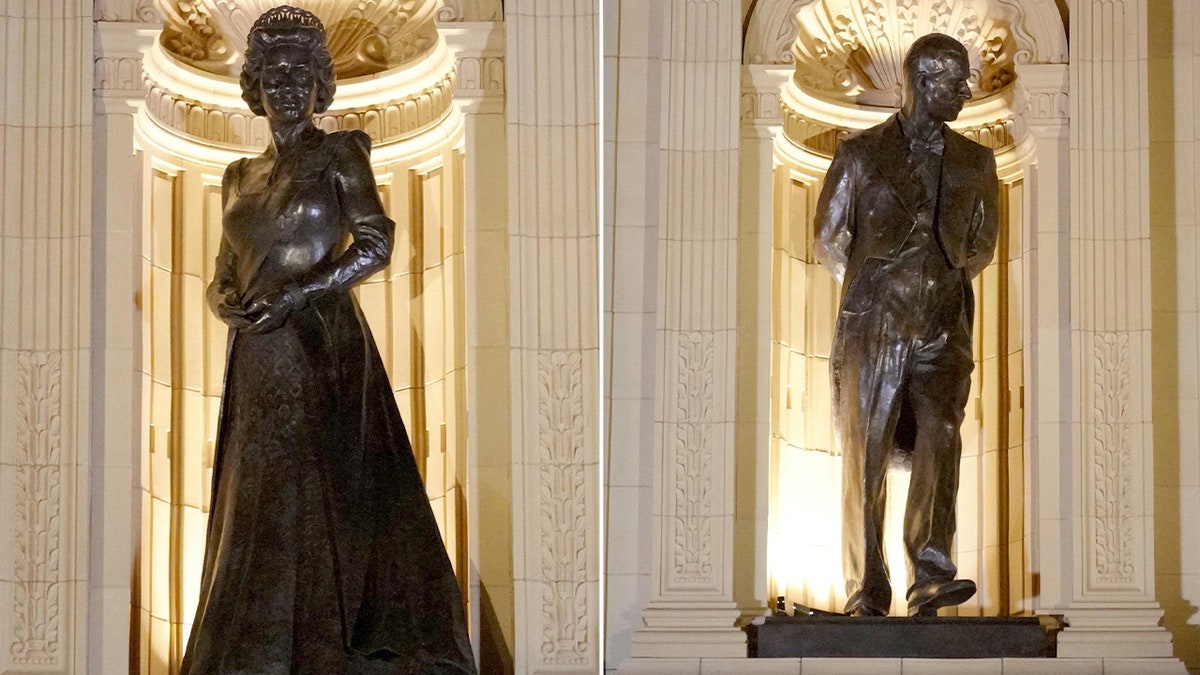
From the very first moment he ascended the throne, King Charles III understood that his duty was not only to carry forward a grand legacy but also to preserve the sacred love he held for his mother — Queen Elizabeth II. One of his most symbolic actions has been the commissioning of statues dedicated to her, placed within royal grounds once reserved solely for ceremony, ensuring that the image of a woman who devoted her entire life to service would be remembered forever.
1. Living Memories Within the Palace
One remarkable detail is the maquette sculpture of the Queen, presented to King Charles by the government of South Australia and now placed in Buckingham Palace. The artwork depicts the Queen in her familiar hat and clutch bag, as though she were still striding through the grand halls. It is both regal and tender, reminding visitors of her constant presence in royal life.
This statue is not only a gift from a Commonwealth nation but also a subtle reminder that every corner of the Palace still breathes with the legacy of the monarch who reigned for 70 historic years.
2. Official Memorials – From York to London
King Charles did not stop with a private keepsake. In November 2022, only two months after her passing, he officially unveiled a statue of Queen Elizabeth II at York Minster. Nearly two meters tall and carved from French Lepine limestone, it portrays her in the robes of the Garter, wearing the George IV diadem, and holding a scepter. Significantly, the Queen herself approved the model design before her death.
Later, at the Festival of Remembrance at the Royal Albert Hall, King Charles and Queen Camilla unveiled bronze statues of both the Queen and Prince Philip. The King was visibly moved as he gazed at the sculptures of his parents — a deeply human moment that resonated with millions.
3. A National Memorial in St James’s Park
Looking further, King Charles initiated an ambitious national project: the creation of a public memorial to Queen Elizabeth II in central London, within St James’s Park.
The plan includes:
-
A statue of the Queen at “Queen Elizabeth II Place” near Marlborough Gate.
-
A double statue of the Queen and Prince Philip at “Prince Philip Gate.”
-
A striking glass bridge inspired by the Mary Fringe Tiara from her wedding.
-
Gardens symbolizing the communities of the United Kingdom and the Commonwealth.
-
A wind sculpture by Yinka Shonibare and quiet spaces for reflection.
The project, led by renowned architect Norman Foster, is scheduled to reveal its full design in spring 2026, marking the Queen’s 100th birthday, with completion expected around 2028.
4. Symbolism and Emotion Behind the Memorial
Linking Past and Future
The memorials are not merely artistic works but living connections between past and future. Through them, Charles emphasizes that the monarchy is both a historical symbol and an inspiration for new generations.
A Testament of Respect and Responsibility
By choosing to honor his mother with statues, Charles expresses profound gratitude. He seeks not only to preserve a personal memory but also to engrave her image permanently into the nation’s heart and history.
Healing Through Art
Each statue and ceremony has been a way for the King to process the grief of losing his mother. They are not grandiose spectacles but gentle, heartfelt acts of remembrance, turning loss into strength to carry forward her legacy.
Conclusion: King Charles – Continuing a Legacy Through Love and Art
From the small maquette in Buckingham Palace, to the grand statues at York and the Royal Albert Hall, and finally to the national memorial planned for St James’s Park, King Charles III has transformed his love for his mother into a living legacy.
These are not simply monuments to be admired; they are places for reflection, bridges between personal love, national memory, and historical continuity. Within each statue, Queen Elizabeth II still lives — an eternal symbol of devotion, perseverance, and boundless love.
